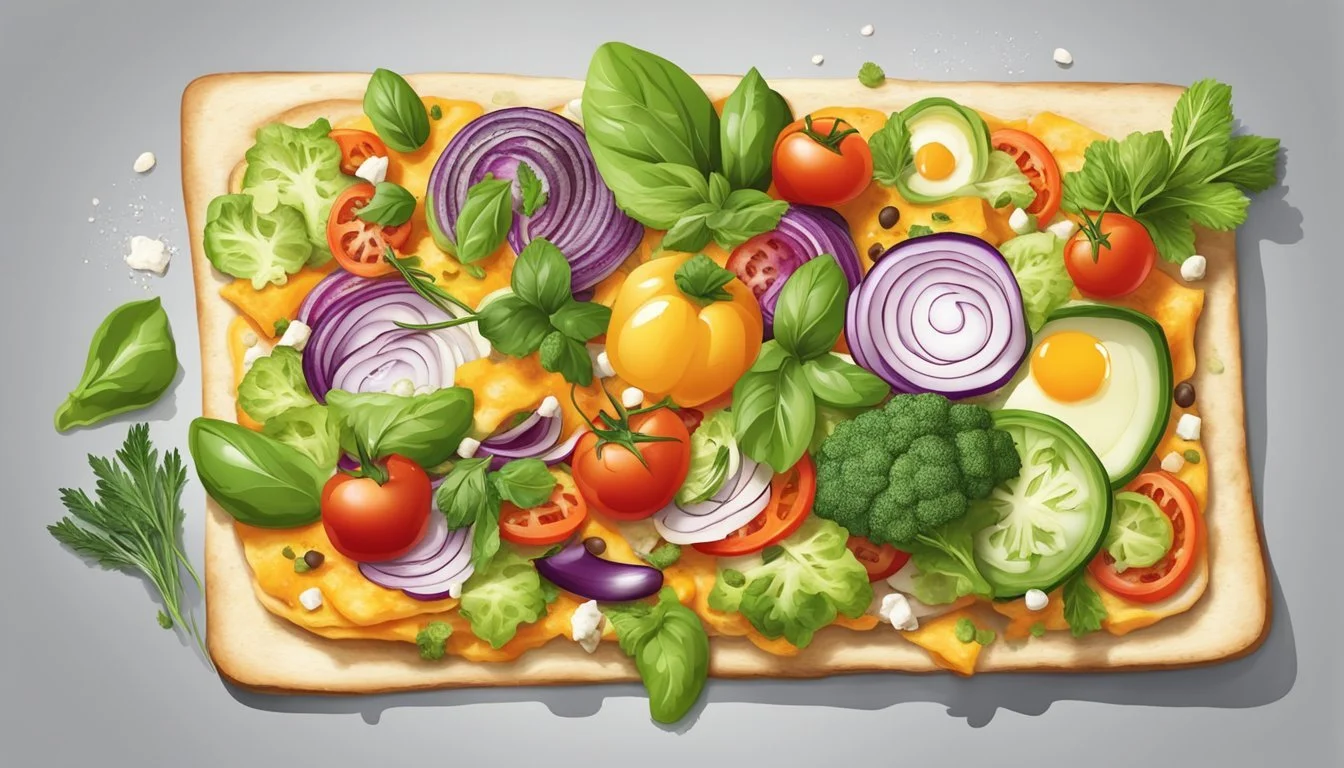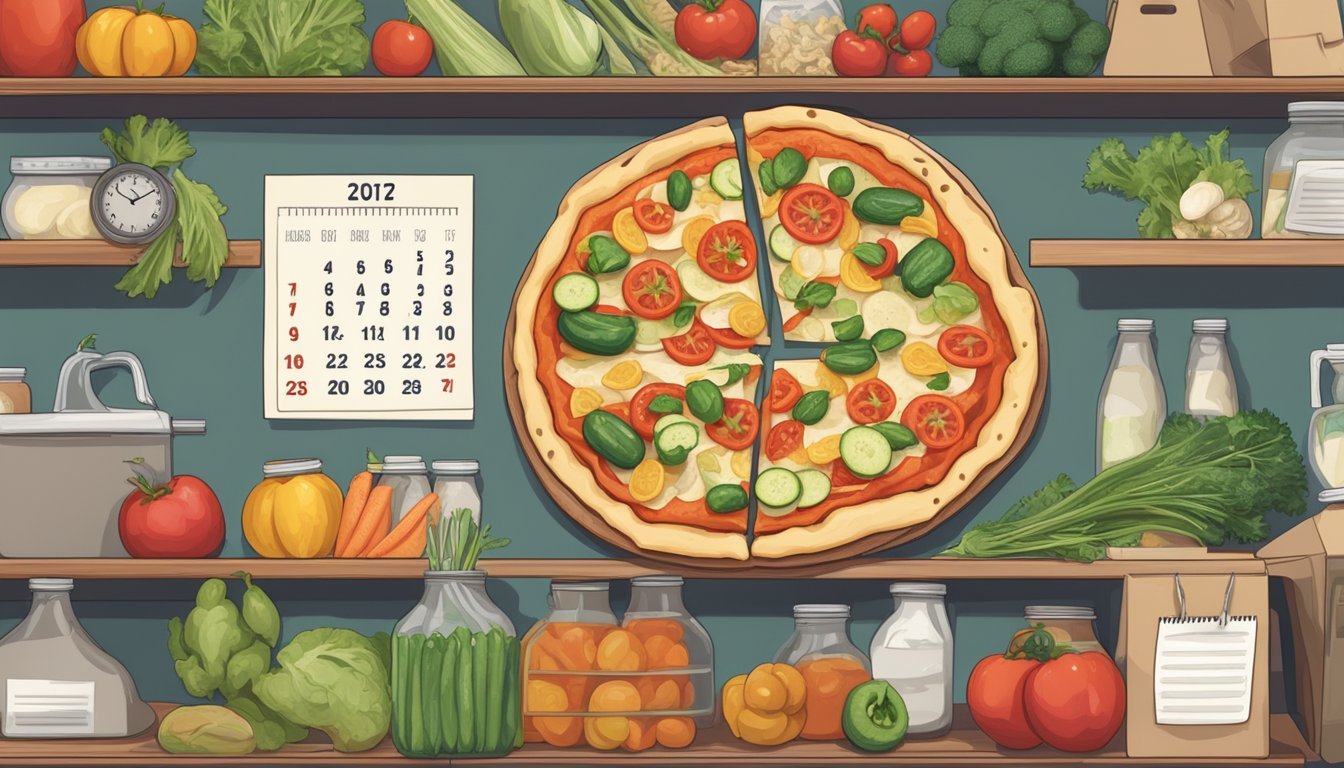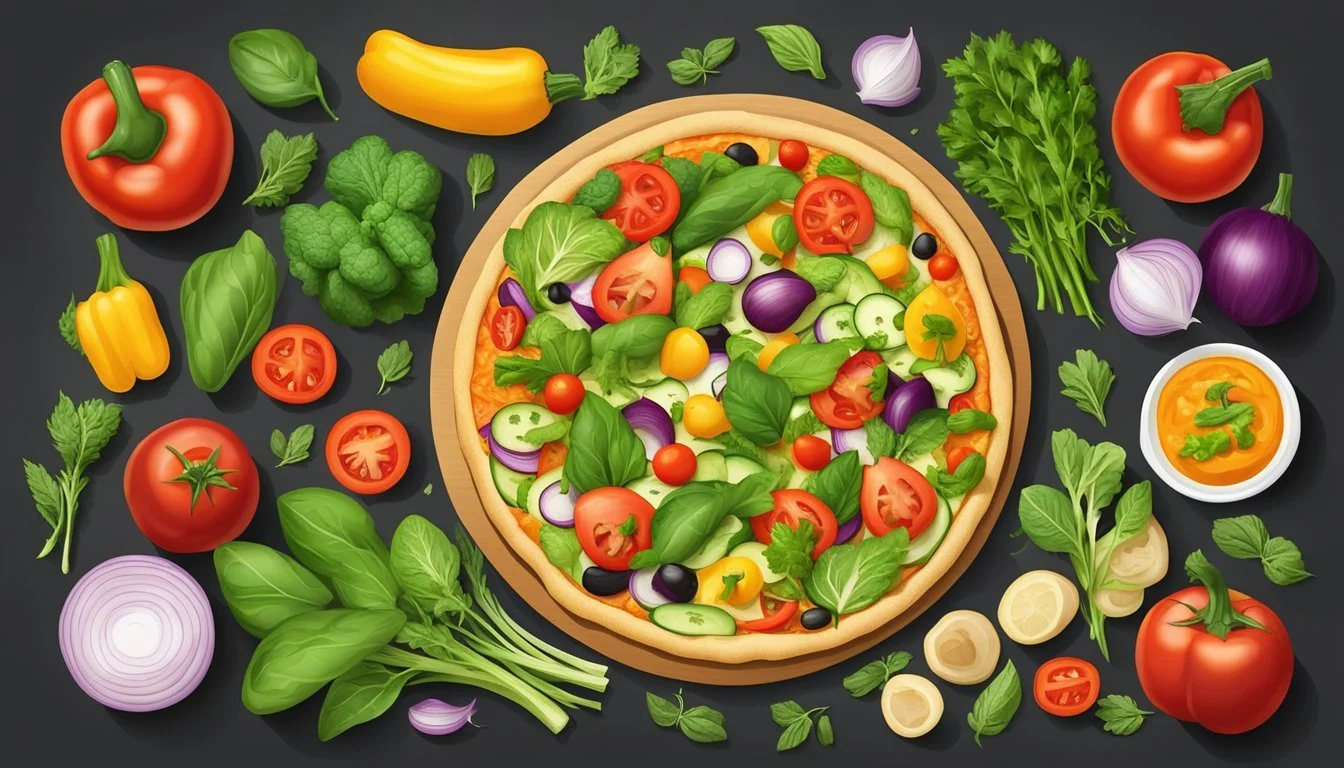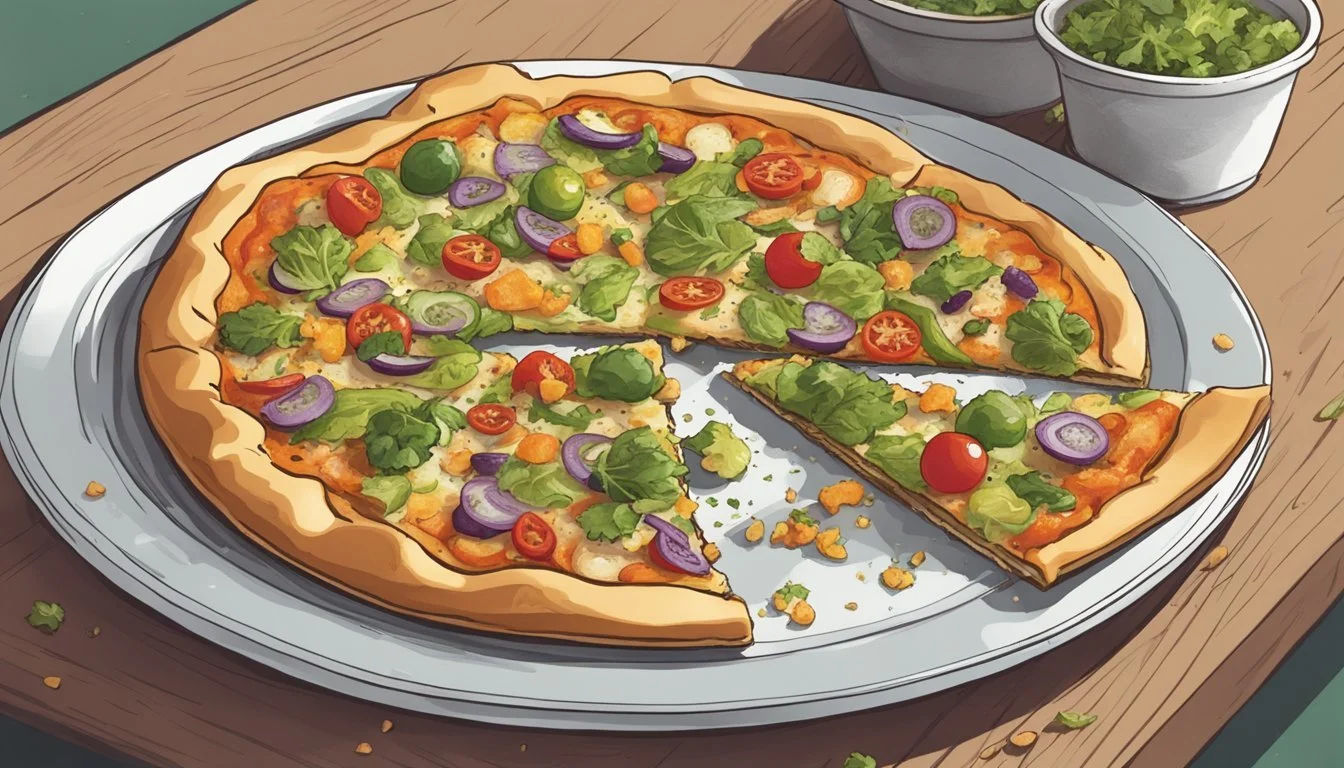How Long Does Flatbread Veggie Pizza Last?
Storage Tips and Shelf Life
Wondering how long your flatbread veggie pizza will last? Shelf life and storage methods are essential to ensure the pizza maintains its flavor and nutritional value. Flatbread veggie pizza can last up to 3-4 days in the refrigerator if properly stored in an airtight container. After this period, the quality and safety may decline due to the perishable nature of the fresh vegetables and cheese typically used as toppings.
Flatbread veggie pizza is a nutritious option, offering a balanced source of carbohydrates, proteins, and fats. With ingredients like bell peppers, artichokes, and mozzarella cheese, each serving provides essential vitamins, fiber, and moderate amounts of sodium and cholesterol. The pizza's calories can vary based on toppings and portion sizes, making it both a delicious and health-conscious choice.
Proper storage not only extends the pizza's shelf life but also preserves its texture and taste. Refrigeration is key, but for longer storage, it can be frozen for up to a month. Keeping these tips in mind ensures you can enjoy your flatbread veggie pizza safely and deliciously over several days.
Composition of Flatbread Veggie Pizza
The components of flatbread veggie pizza include high-quality ingredients and commonly used toppings which enhance flavor and nutritional value. Each element plays a vital role in creating a delicious and nutritious meal.
Quality of Ingredients
Flatbread forms the base and is often made from simple ingredients such as flour, water, and yeast. Olive oil is usually incorporated into the dough to impart flavor and improve texture. The sauce, often a tomato base, contains herbs like garlic, basil, and black pepper for seasoning.
Cheeses such as mozzarella, parmesan, and sometimes feta are used for their meltability and taste. Fresh vegetables including bell peppers, spinach, zucchini, onions, and mushrooms are key toppings, offering both taste and nutritional benefits. Quality ingredients ensure not only better flavor but also longer freshness and health benefits.
Common Toppings
Common toppings on veggie flatbread pizzas include an array of fresh vegetables and flavorful cheeses. Bell peppers add sweetness and color, while onions bring a sharp taste. Tomatoes are often used fresh or as part of the sauce, offering a tangy base flavor.
Spinach and zucchini provide nutrients and a pleasant texture. Mushrooms add umami and earthiness. Mozzarella cheese is frequently used for its excellent melting properties, and parmesan or feta may be added for extra flavor.
Herbs like basil give a fresh taste. These toppings not only enhance the pizza's flavor but also contribute to its nutritional value, making the flatbread veggie pizza both a delicious and healthy option.
Nutritional Content
Veggie flatbread pizza offers a balance of macronutrients and essential vitamins and minerals. Below, the key nutritional components are broken down to provide a clear understanding of what this meal offers.
Macronutrients
A standard serving of veggie flatbread pizza averages around 623 calories. It contains approximately 24 grams of fat, including 12 grams of saturated fat. Carbohydrates make up about 76 grams per serving, providing much of the calorie content.
The pizza also includes around 21 grams of protein, which helps repair and build tissues. Additionally, the dish provides dietary fiber, which aids in digestion. On average, it offers about 4 grams of fiber per serving, contributing to daily fiber intake.
Vitamins and Minerals
Veggie flatbread pizza is a source of several essential vitamins and minerals. It typically provides around 60% of the daily value for Vitamin A, important for vision and immune function, and 35% of the daily value for Vitamin C, which helps with skin health and immune support.
It also contains essential minerals such as Calcium, necessary for bone health, often making up about 20% of the daily value. Iron, which is crucial for blood health, is also present, contributing roughly 15% of daily needs. Additionally, Potassium, vital for heart and muscle function, is contained in moderate amounts, at about 10% of the daily value per serving.
Preparation and Baking Tips
When making a flatbread veggie pizza, ensuring the dough and base are well-prepared, correctly assembling the pizza, and utilizing optimal baking techniques are essential for a delicious outcome.
Dough and Base
Start by selecting the right dough for the flatbread pizza. Pre-made crusts like naan bread or store-bought flatbread save time. If making dough from scratch, mix flour, water, yeast, a pinch of sugar, and salt. Allow it to rise until doubled in size.
Using naan bread is a convenient option. Lightly brush the flatbread or naan with olive oil before adding toppings. This step provides a crunchy base and prevents sogginess from the toppings.
Assembling the Pizza
Begin with a layer of sauce. Pesto or traditional pizza sauce works well. Spread it evenly to avoid uneven cooking. An even distribution of sauce ensures consistent flavors in every bite.
Top with fresh vegetables. Popular choices include artichokes, mushrooms, and bell peppers. To enhance flavor, season the vegetables with a dash of salt, pepper, and Italian seasoning.
Sprinkle mozzarella cheese evenly. For extra taste, add a few fresh basil leaves before baking. Ensure the toppings don't overcrowd the pizza to avoid undercooking.
Optimal Baking Techniques
Preheat the oven to around 425°F (220°C). A preheated oven ensures the pizza cooks evenly and develops a crisp crust. For a crispier base, use a pizza stone or a preheated baking sheet.
Bake the flatbread pizza for 10-15 minutes, or until the cheese melts and turns golden brown. Monitor the pizza closely to avoid overbaking. A well-baked flatbread pizza will have a crispy edge and a slightly chewy center.
Allow the pizza to cool for a couple of minutes before slicing. This resting period helps the cheese set, making it easier to cut and serve without the toppings sliding off.
Proper Storage Methods
Proper storage of flatbread veggie pizza is essential to maintain its freshness and flavor. Both short-term refrigeration and long-term freezing techniques can significantly affect the longevity of your pizza.
Short-Term Storage
For short-term storage, place leftover flatbread veggie pizza in an airtight container or wrap it tightly in aluminum foil. This method minimizes air exposure and prevents the crust from becoming too hard.
Store the wrapped or container-sealed pizza in the refrigerator. The refrigerator should be set to a temperature below 40°F (4°C) to inhibit bacterial growth. Properly stored, the flatbread veggie pizza will last 3 to 4 days.
If reheating, preheat the oven to 350°F (175°C) and bake for 10-15 minutes. This keeps the crust crispy and the toppings flavorful. Alternatively, use a microwave on high for 1-2 minutes per slice.
Long-Term Freezing
For long-term freezing, wrap the fresh or leftover flatbread veggie pizza tightly in plastic wrap, then in aluminum foil to prevent freezer burn. Label the package with the date. The double-layer wrapping ensures maximum freshness.
Place the wrapped pizza in a freezer-safe bag or container. Stored in the freezer at or below 0°F (-18°C), the pizza can last up to 3 months.
When ready to consume, thaw the pizza in the refrigerator overnight. Reheat by preheating the oven to 350°F (175°C) for 10-15 minutes, ensuring the pizza is heated evenly and retains its texture and taste.
Proper freezing techniques and adequate thawing help preserve the flavor and texture of the flatbread veggie pizza, providing a convenient meal option even after several months.
Shelf Life Considerations
The shelf life of flatbread veggie pizza varies based on both the ingredients used and environmental conditions. Understanding these factors helps in maintaining its freshness and safety for consumption.
Influence of Ingredients
Store-Bought vs. Homemade: Store-bought flatbread veggie pizzas often contain preservatives that extend their shelf life. These pizzas can generally last longer in the refrigerator compared to homemade versions, which lack such additives.
Toppings: The type of vegetables used as toppings significantly impacts shelf life. Fresh vegetables tend to have higher water content, which can lead to sogginess and quicker spoilage. Cooking the vegetables before topping the pizza can help reduce moisture and extend shelf life.
Crisp: The crispness of the flatbread can deteriorate faster if not stored properly. To maintain its texture, it’s crucial to wrap the pizza securely in plastic wrap or aluminum foil.
Environmental Factors
Storage Temperature: Refrigeration is key in prolonging the shelf life of flatbread veggie pizza. It should be stored at or below 40°F (4°C). At this temperature, the pizza can last 3-4 days. For longer preservation, freezing is advisable, allowing it to be stored for up to 3 months.
Packaging: Airtight packaging is essential to keep the pizza fresh. Using resealable bags or airtight containers prevents exposure to air and moisture, which can lead to faster deterioration. For frozen storage, wrapping individual slices in plastic wrap before placing them in a freezer bag provides better preservation.
Room Temperature: Flatbread veggie pizza should not be left at room temperature for more than 2 hours. Beyond this period, bacterial growth may increase, making the pizza unsafe to eat.
Serving Recommendations
Flatbread veggie pizza is versatile and suitable for various occasions such as dinner, lunch, or as a quick and easy appetizer. This section provides specific tips on portion sizes and serving conditions to enhance your experience.
Appropriate Portion Sizes
When serving flatbread veggie pizza, consider the setting and the nature of the meal. For a dinner or lunch, one whole flatbread per person is an appropriate serving size. If using the pizza as an appetizer, cutting the flatbread into smaller squares or triangles can make it easier to share.
For individual servings, a slice typically contains fresh mozzarella, goat cheese, or feta. The addition of these cheeses provides richness and balances the lighter vegetables like cherry tomatoes and red onions. To determine the ideal portion sizes, consider using 1/2 cup of cherry tomatoes and 1/4 cup of red onion per flatbread.
Serving Conditions
The best way to appreciate the flavors of flatbread veggie pizza is by ensuring the proper serving conditions. Serve the pizza hot, right out of the oven, with melted cheese and crisp edges. Preheat your oven to 425°F and bake until the cheese melts and the crust crisps up, around 10-12 minutes.
For added flavor, top with a drizzle of olive oil or balsamic glaze. Keep the flatbread warm by placing it on a preheated stone or serving tray. This is especially useful during a dinner party where pizzas can cool quickly. Pair the pizza with a fresh salad for a complete, balanced meal.
Health and Dietary Benefits
Flatbread veggie pizza offers various advantages for those looking to maintain a healthy diet. These pizzas are rich in nutrients such as fiber and protein while often being lower in calories compared to traditional pizzas with meat toppings.
Weight Management
Flatbread veggie pizzas are an excellent option for those monitoring their weight. The use of vegetables like spinach, bell peppers, and olives adds fiber to the meal, enhancing fullness and aiding digestion.
By choosing flatbread over thicker crusts, calorie intake is reduced. Mozzarella cheese, when used in moderation, provides necessary protein without adding excessive fat. In comparison to meat toppings, which are often higher in calories and fat, veggie toppings keep the meal lighter.
Pizzas that incorporate cauliflower or whole wheat flatbreads also offer lower-carb options, making this dish more diet-friendly. The balance of fiber from vegetables and the reduced carb content of flatbread can help manage weight effectively.
Dietary Restrictions
For individuals with specific dietary restrictions, flatbread veggie pizzas can be tailored to fit various needs. For example, using a gluten-free flatbread satisfies those with gluten sensitivities or celiac disease.
Vegetables like artichokes, mushrooms, and marinated vegetables not only enhance flavor but also keep the pizza nutrient-dense. Veggie toppings are naturally low in cholesterol and fit well in heart-healthy or plant-based diets.
By substituting regular cheese with vegan alternatives, like dairy-free mozzarella, flatbread veggie pizzas become suitable for lactose intolerant or vegan individuals. Additionally, controlling the oil and cheese quantities can make the pizza suitable for low-fat or low-sodium diets, making it a versatile option for many dietary needs.
Creative Variations
Enhancing your flatbread veggie pizza can be achieved by exploring different types of flatbreads and introducing international flavors. This section provides insights into various flatbread options and flavor inspirations.
Alternative Flatbread Choices
Experimenting with different flatbreads can elevate the taste and texture of your veggie pizza. Naan offers a slightly chewy and airy base, ideal for Mediterranean-style pizzas topped with hummus, roasted veggies, and kalamata olives. Roti provides a thinner, more flexible crust that works well with lighter toppings like fresh tomatoes, zucchini, and basil.
Lavash is another option, providing a crispier texture and a unique palate experience. It pairs well with eggplant, jalapeno, and a sprinkle of ground black pepper for a more robust flavor.
International Flavors
Incorporate global tastes to create unique veggie flatbread pizzas that stand out. For a Mediterranean twist, top your flatbread with marinated artichokes, bell peppers, and oregano. Add a touch of heat with red pepper flakes and kalamata olives for a bold finish.
Exploring Asian flavors, use a base of sesame seeds and soy sauce, topped with roasted veggies like eggplant and bell pepper. Garnish with fresh herbs such as cilantro or basil to enhance the overall taste.
Creating these variations offers a world of flavor combinations and ensures that your flatbread veggie pizza remains exciting and delicious.
Food Safety Concerns
Ensuring the safety of flatbread veggie pizza involves preventing contamination and achieving proper cooking temperatures.
Contamination Prevention
Preventing contamination starts with the ingredients. Always use fresh vegetables and clean them thoroughly before use. Keep raw vegetables separate from any meats or other raw proteins to avoid cross-contamination.
Use clean utensils, cutting boards, and surfaces. Bacteria can linger on improperly cleaned items, potentially contaminating your flatbread.
When storing cooked flatbread veggie pizza, use airtight containers or wrap it tightly with plastic wrap or aluminum foil. Label with dates to keep track of freshness. Refrigerate the pizza at temperatures below 40°F (4°C) to inhibit bacterial growth.
Proper Cooking Temperatures
The oven should be preheated to around 375°F (190°C) to ensure the flatbread cooks evenly. Cooking time typically ranges from 10-12 minutes, depending on the desired crispiness of the pizza edges and the melt of the cheese.
Place the flatbread on a baking sheet lined with parchment paper or lightly coated with cooking spray to prevent sticking.
Achieving the proper internal temperature is crucial. Use a food thermometer to ensure the internal temperature reaches at least 165°F (74°C). This helps kill any harmful bacteria present.
Carefully monitor the cooking process to avoid undercooking, which can leave areas where bacteria might thrive. Ensure that any toppings, especially those added after baking, are also free from contamination.
Social Media and Community Engagement
Sharing your flatbread veggie pizza creations on social media platforms like Pinterest and Instagram can help you connect with fellow food enthusiasts and showcase your culinary skills.
Showcasing Your Creations
Platforms such as Pinterest and Instagram offer the perfect stage to display your homemade flatbread veggie pizza. High-quality photos and engaging captions can attract a wide audience.
Use specific hashtags like #FlatbreadPizza and #VeggiePizza to increase visibility. Including details like whether you used a store-bought or homemade yeast pizza crust can add depth to your posts. Followers often appreciate knowing the specifics about your pizza recipes. Sharing short videos of the cooking process can also boost engagement and attract more viewers.
Engaging With Fellow Food Enthusiasts
Engagement plays a crucial role in building a community around your pizza creations. Respond to comments and questions promptly to foster interaction. Engage with content from other food enthusiasts by liking, commenting, and sharing their posts.
Joining and actively participating in food-themed groups or forums can also provide new ideas and inspiration. Collaborating with other food bloggers or influencers through events like Pizza Fridays or recipe exchanges can amplify reach and introduce your flatbread veggie pizza to a broader audience.
Economic Aspects
Flatbread veggie pizza offers various economic benefits, particularly for those looking to stay budget-conscious and efficient in their meal planning. The use of cost-effective ingredients and the potential for batch cooking contribute to its affordability and practicality.
Cost-Effective Ingredients
Flatbread veggie pizzas make use of budget-friendly ingredients. Vegetables such as bell peppers, zucchini, and onions are not only nutritious but also inexpensive, especially when bought in season. Using flatbread as a base is another economical choice, as it tends to be cheaper than traditional pizza dough.
Cheese can be used sparingly while still providing flavor, saving costs. Opting for a modest amount of mozzarella allows for both taste and budget management. Incorporating pantry staples like olive oil and salt helps minimize the need for additional purchases, making flatbread veggie pizzas a thrifty meal option.
Meal Planning Efficiency
Flatbread veggie pizzas excel in meal prep and batch cooking, enhancing their economic efficiency. Preparing several pizzas at once and storing them in the fridge or freezer ensures meals are ready throughout the week. They can be easily reheated, saving time and reducing the temptation to spend on takeout.
This meal prep strategy not only cuts down on food waste but also maximizes the use of purchased ingredients. Batch cooking also leverages the power of economies of scale, making it cheaper per serving. This flexibility makes flatbread veggie pizza an excellent choice for planning family meals or managing a busy schedule efficiently.
Conclusion
Vegetable Flatbread Pizza offers a delightful combination of flavors and nutritional benefits. High in fiber and various vitamins, this pizza serves as a nutritious meal option.
Regarding shelf life, properly stored flatbread veggie pizza lasts 2-3 days in the fridge. Airtight containers are essential for maintaining freshness.
For longer storage, freezing is effective. Wrap the pizza tightly in plastic wrap or aluminum foil before placing it in a freezer bag.
To enjoy frozen veggie flatbread pizza, allow it to thaw in the fridge before reheating it in the oven at 350°F until hot.
Adhering to these storage methods ensures that veggie pizass remain fresh and flavorful, allowing for enjoyable meals even on busy days.












